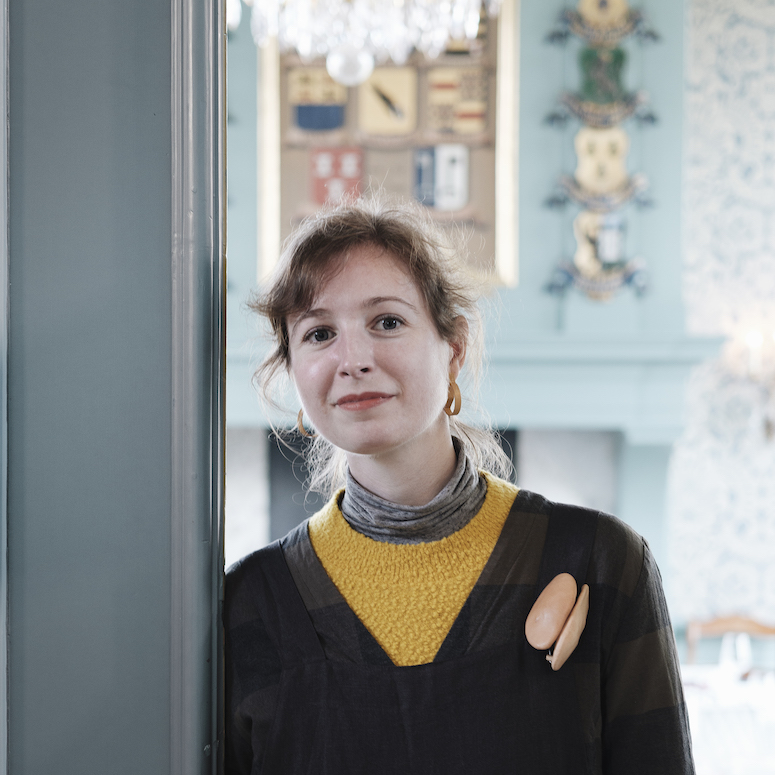
Rachael Colley
Rachael Colley is an interdisciplinary artist living and working in the UK. Her work brings together jewellery, created predominantly using food waste, and ambiguous artefacts for eating. She invites users to wear these visceral jewellery pieces whilst consuming food with her sculptural dining tools.
If you had access to all the powers, how would you improve the world?
Wow. It’s a big question! The whole world needs a massive overhaul and everyone must work together to effect change. I believe that designers and artists have the potential to apply their creativity in a variety of ways in order to support the environment and to combat climate change.
What are the biggest sustainability challenges in your work and how are you addressing them?
Where possible I’m using organic waste materials to create new works. When I choose to use materials such as metal I try to research their origins where possible to ensure that they have been ethically and sustainably sourced, but this information is a challenge to discover in most cases. I focus on the outcome’s end-point at the start of my design process, considering how the metal components can be recycled in the final stage of their life cycle.
Which conscious lifestyle choices are you making? And are you considering any new ones?
I’ve become a vegetarian and I’m learning more about the ways in which I can reduce my carbon footprint by eating seasonal fruits and vegetables. I’m aiming to grow more of my own food in the future and I’m being resourceful by collecting natural materials that I can transform into useful household items, such as making clothes washing detergent from horse chestnuts.
What have you rebelled against in the past, and what are you rebelling against now?
I suffer from auto-immune diseases, which cause my body to constantly attack itself. I’m constantly rebelling against myself by trying to control my body, physically and mentally, which is the main inspiration behind the artwork I create.
Do you think cutlery can still be improved? If yes, in what way?
Cutlery generally tends to impede your eating experience, as it’s designed as a hygienic intermediary that conveniently and proficiently facilitates the negotiation between body and food. It’s problematic because, in many ways, it lessens the range of sensory aspects associated with our dining experience and efficiently speeds it up. I believe that we should aim to regularly interrupt our normalised dining experience by creating a series of dissociations in various ways, to slow us down and encourage us to reconsider and re-engage with the way we consume food. I do this by reimagining tools for eating and also creating jewellery from food waste, both of which are designed to be used and worn whilst eating.
What was the inspiration for your Steinbeisser pieces?
The first pieces in this series of Cutlery Combs were originally designed and created to feature in Ambiguous Implements, an Arts Council England funded national touring exhibition. The artefacts cross-reference bodily tools for grooming and dining, with the aim of forming abject associations that tread the line between playfulness and underlying feelings of disgust. These pieces have since gone on to develop a close connection with my own bodily sensations, correlating with my personal experience of eating, as they present challenges to the user and slow them down. I suffer from systemic sclerosis, a form of auto-immune disease that affects the function of my oesophagus through the hardening of internal skin surfaces and muscles. This makes normalised acts, such as swallowing, challenging and as a result I tend to eat smaller portions of more ‘swallowable’ foods at frequent intervals throughout each day. The series also indicates the importance of portion size through their varied scales and powder-coated surface areas, as food should only be consumed from the stainless steel.
Describe your work in 3 words!
Challenging. Playful. Disgusting.
What kind of materials do you use and where do you get them from?
The Cutlery Combs and for-K-andle pieces are made of re-purpose stainless steel forks and fork handles predominantly obtained from the Sheffield cutlery industry, but also from Ebay and charity shops. They are then soldered to form mild steel comb frames and powder-coated.
What has been your favorite dinner experience?
Jelly and ice cream as a child at kids parties.
What excites you about tomorrow?
Any opportunity to learn and experience something new.